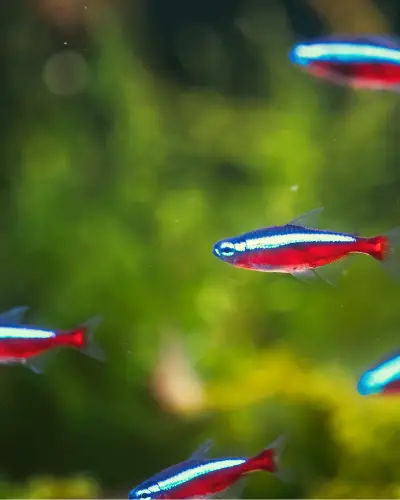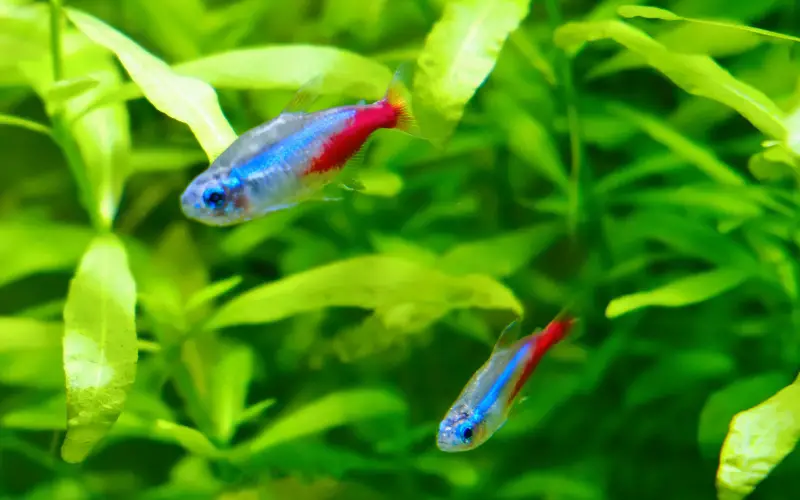Neon tetras, with their shimmering colors and peaceful nature, are among the most beloved aquarium fish. If you’re wondering what do neon tetras eat to maintain their vibrant hues and lively behavior, the answer lies in a carefully balanced diet that mimics their natural feeding habits.
Whether you’re a new aquarist or a seasoned fish keeper, ensuring your neon tetras receive the proper nutrition is key to keeping them healthy and happy.
Feeding neon tetras isn’t just about sprinkling any fish food into their tank; it’s about variety and quality. These tiny swimmers thrive on fine flake food, small granules, live or frozen brine shrimp, and daphnia.

You can also treat them to frozen or freeze-dried bloodworms for a protein-rich addition to their meals. A diverse diet not only enhances their colors but also supports their overall health and energy levels.
In this guide, we’ll dive deeper into the best food choices, feeding tips, and common mistakes to avoid, so your neon tetras can truly shine in your aquarium.
Let’s explore how you can turn every feeding session into a nutritious feast for your vibrant little companions!
Table of Contents
ToggleWhat Do Neon Tetras Eat in a Tank?
Neon tetras are tropical community fish that enjoy a planted tank setting. They prefer various foods in a fish tank, including flake food, micro pellets, sinking pellets, and frozen daphnia.
They may also eat live or frozen baby brine shrimp and bloodworms. These small fish go to the surface for food and put their stomachs to work.
The appropriate fish food for neon tetras will usually sink slowly or float in the water. It is worth considering a quality food such as Hikari or Fluval bug bites for feeding. Neon tetras cannot eat larger foods like goldfish flakes and granule foods, so keep their size in account.
Feed neon tetras daily and only give them as much food as they can eat immediately. Overfeeding can lead to health issues such as obesity or digestive <
What to Feed Neon Tetras: A Detailed Overview of Neon Tetra Fish Feeding
What Are you Feeding your Neon Tetras? Neon tetras are known to be quite picky eaters, so it’s essential to offer them a variety of foods to meet their nutritional needs. They typically pick at anything smaller than them, such as betta pellets or small live worms.
A good diet for tetras usually consists of dry flakes, freeze-dried bloodworms, and live or frozen foods. Some owners have mentioned that their tetras are pretty shy and will only eat when hungry, so pouring in a small amount of food at a time is essential to avoid overfeeding.

When feeding neon tetras, it’s always best to avoid caution and feed them smaller amounts throughout the day.
It’s also worth noting that red stripe tetras have a relatively short lifespan compared to other tank mates, so maintaining a good diet is crucial to their overall health and well-being. Diseases like neon tetra can quickly spread through a tank if the fish lack proper nutrition.
To prevent this, owners should consider adding foods, including unique tetra formula flakes and sinking wafers that will reach the bottom of the tank for the less adventurous eaters.
If you have larger fish in the tank with your tetras, it may not work best to feed them the same diet. The Neons will generally swim closer to the surface, while larger fish like Rasboras or livebearers may prefer to feed lower in the tank.
You can also create a neon tetra feeding schedule that offers different types of food at other times of the day, depending on the fish in your tank. Following these guidelines can help ensure your fish remain healthy and neon tetra disease-free for years.
7 Best Foods for Neon Tetra Health and Vibrating
Neon tetras are small, colorful freshwater fish that are popular aquarium additions. You’ll want to provide a varied diet that includes live and prepared foods to keep them vibrant and healthy. Here are 7 of the best foods for neon tetras:
- Brine Shrimp are an excellent live food for neon tetras, especially for young fry. They are rich in protein and essential fatty acids, which can help promote growth and development. You can buy frozen or live brine shrimp, which are relatively easy to hatch at home.
- Daphnia:Another great live food option, daphnia are small crustaceans that are similar to brine shrimp in nutritional value. They are also a good source of protein and fatty acids, and they can help to keep your neons active and healthy.
- Microworms: Microworms are even smaller than brine shrimp and daphnia, making them a good choice for feeding fry and tiny fish. They are also a good source of protein and other nutrients.
- Bloodworms: Bloodworms are an excellent source of protein and iron. They can be fed to tetras occasionally as a treat, but they should not be a staple food because they are high in fat.
- Flake Food: Many different types of flake food are available for neon tetras. Choose a high-quality flake food that is specifically formulated for small fish. A good flake food will contain a variety of proteins, vitamins, and minerals that your fish need to stay healthy.
- Pellet Food: Pellet food is another good option for tetras. It is slow-sinking, which allows neon tetras to eat it at their own pace. Choose a pellet food that is the right size for your fish.
- Freeze-Dried Foods: Freeze-dried foods are a convenient way to give your tetras various nutrients. Freeze-dried brine shrimp, daphnia, and bloodworms are all excellent options.
By feeding your tetras a varied diet of these foods, you can help them stay healthy and vibrant for many years.
Neon Tetra Health & Aquarium Requirements
Neon Tetras are beautiful and vibrant fish that can bring life to any aquarium. To learn about their health and aquarium requirements, it’s essential to do your research and talk with other hobbyists to hear their experiences.
One standard piece of advice is to provide a well-maintained aquarium with the appropriate acidic water parameters for the tetra’s well-being. To reduce stress levels, keep them in a school of at least six. A good-quality filter is a second necessity, as Tetras are sensitive to water quality.
A usual recommendation is to have a hob or hang-on-back filter to keep the water clean. Sudden changes in water parameters can scare them, so it’s crucial to monitor the levels regularly and address any issues promptly.
Commonly Asked Questions about Neon Tetra Feeding (FAQs)
How often do you feed neon tetras?
How often should I feed neon tetras? Aim to feed tetras fish twice daily, offering only what they eat in a few minutes. This keeps them healthy and prevents water quality issues from excess food.
How long can neon tetras go without food?
Neon tetras can survive for one to two weeks without feeding, but for optimal health, they should aim for small meals twice daily.
Do neon tetras eat fruit?
They can nibble on fruits and veggies to supplement their diet. But chop them tiny and offer them sparingly, as their primary food source should be meaty flakes or pellets.
What food should I feed my neon tetra?
Neon tetras thrive on a varied diet of high-quality flakes, pellets, and occasional treats like brine shrimp or bloodworms.
What is the best food to feed neon tetras?
Best food for neon tetra: Tetras thrive on high-quality flake foods, supplemented with occasional treats like brine shrimp or daphnia.
Can neon tetras eat grapes?
While they may nibble on grapes, a better option is to stick to flakes, pellets, or frozen brine shrimp for a healthy diet. Grapes are difficult to digest and offer minimal nutrients.
Do neon tetras eat cucumber?
Yes, neon tetras will nibble on cucumbers. But chop them tiny and blanch them to soften them for their small mouths. Their primary diet should be high-protein flakes or pellets with occasional veggies for variety.
Can tetras eat blueberries?
While not harmful occasionally, blueberries aren’t ideal for tetras. Their small size and lack of nutrients make them a poor substitute for a balanced fish diet. Stick to high-quality fish food for tetras’ health.
How much food does a neon tetra need?
Feed neon tetras a small amount twice a day that they can consume in 2 minutes. Their tiny stomachs can’t handle much!
Is it okay to feed neon tetras once a day?
Feeding neon tetras once a day is all right, but twice daily is ideal. Offer small amounts they can finish in 2 minutes to avoid overfeeding and water quality issues.
What do neon tetras eat in the wild?
Neon tetras are omnivores that feast on tiny insects, larvae, algae, and even plant matter in the Amazon’s slow-moving waters in South America.
Conclusion
So, what to feed neon tetras in a home tank? The right environment and a varied diet ensure your red stripe tetras thrive and display vibrant colors. Following the tips above, you can create a healthy and stimulating natural habitat where your neon tetras will flourish. Remember, a well-cared-for fish is a happy fish, and happy fish reward you with their dazzling beauty and playful energy.
So, take the time to invest in the well-being of your neon tetras. With a little effort and the proper knowledge, you can enjoy these captivating species of fish for years to come. And if you’re still wondering “What do neon tetras eat?” – refer to this guide, and you’ll have all the information you need to keep your fish happy, healthy, and brightly colored!
Recommended Posts
- How Long Do Neon Tetras Live: (Unlock Their HIDDEN Lifespan)
- How Big Do Neon Tetras Get: (Size Guide for Neon Fish Species)
- The Ideal Neon Tetra Temp: (Comprehensive Care Guide)
- Best Neon Tetra Tank Mates – 7 Stunning Companions
- Neon Tetras Caring Tips for Beginners (Experts Advice)
- How Long Can Neon Tetra Go Without Food: (Survival Guide!)
- Maintaining the Best pH Level for Neon Tetras: (Expert Advice)
- Can Neon Tetra Eat Betta Food: (The Shocking Truth)
- How Often to Feed Ember Tetras & How Much: Feeding Schedule!




